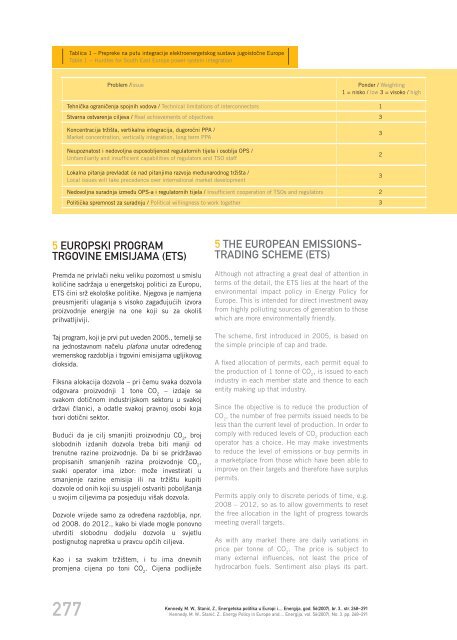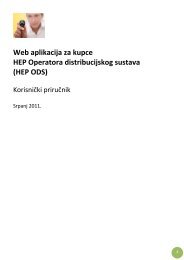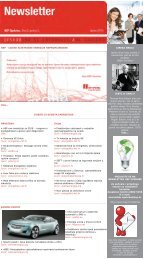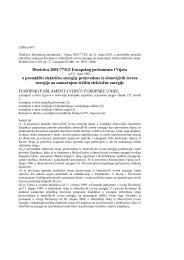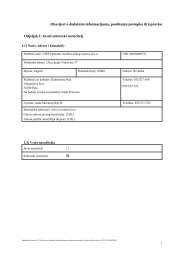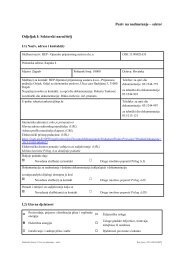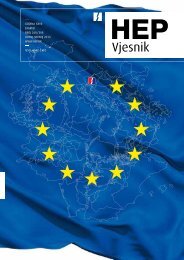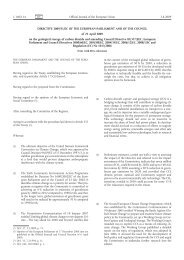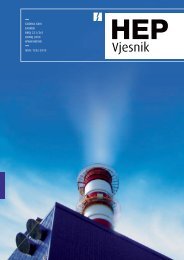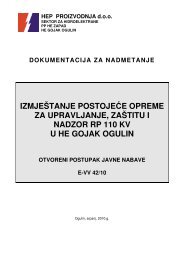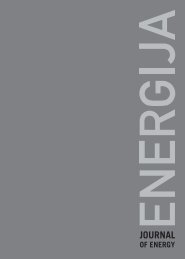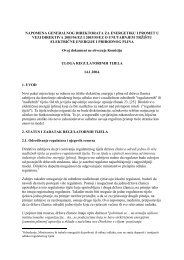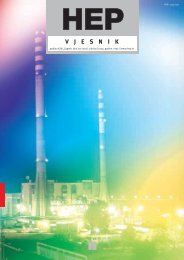You also want an ePaper? Increase the reach of your titles
YUMPU automatically turns print PDFs into web optimized ePapers that Google loves.
Tablica 1 ∑ Prepreke na putu integracije elektroenergetskog sustava jugoistoËne Europe<br />
Table 1 − Hurdles for South East Europe power system integration<br />
Problem /Issue<br />
TehniËka ograniËenja spojnih vodova / Technical limitations of interconnectors<br />
Stvarna ostvarenja ciljeva / Real achievements of objectives<br />
Koncentracija træiπta, vertikalna integracija, dugoroËni PPA /<br />
Market concentration, vertically integration, long term PPA<br />
Neupoznatost i nedovoljna osposobljenost regulatornih tijela i osoblja OPS /<br />
Unfamiliarity and insufficient capabilities of regulators and TSO staff<br />
Lokalna pitanja prevladat Êe nad pitanjima razvoja meappleunarodnog træiπta /<br />
Local issues will take precedence over international market development<br />
Nedovoljna suradnja izmeappleu OPS-a i regulatornih tijela / Insufficient cooperation of TSOs and regulators<br />
PolitiËka spremnost za suradnju / Political willingness to work together<br />
Ponder / Weighting<br />
1 = nisko / low 3 = visoko / high<br />
1<br />
3<br />
3<br />
2<br />
3<br />
2<br />
3<br />
5 EUROPSKI PROGRAM<br />
TRGOVINE EMISIJAMA (ETS)<br />
Premda ne privlaËi neku veliku pozornost u smislu<br />
koliËine sadræaja u energetskoj politici za Europu,<br />
ETS Ëini sræ ekoloπke politike. Njegova je namjena<br />
preusmjeriti ulaganja s visoko zagaappleujuÊih izvora<br />
proizvodnje energije na one koji su za okoliπ<br />
prihvatljiviji.<br />
Taj program, koji je prvi put uveden 2005., temelji se<br />
na jednostavnom naËelu plafona unutar odreappleenog<br />
vremenskog razdoblja i trgovini emisijama ugljikovog<br />
dioksida.<br />
Fiksna alokacija dozvola ∑ pri Ëemu svaka dozvola<br />
odgovara proizvodnji 1 tone CO 2<br />
∑ izdaje se<br />
svakom dotiËnom industrijskom sektoru u svakoj<br />
dræavi Ëlanici, a odatle svakoj pravnoj osobi koja<br />
tvori dotiËni sektor.<br />
BuduÊi da je cilj smanjiti proizvodnju CO 2<br />
, broj<br />
slobodnih izdanih dozvola treba biti manji od<br />
trenutne razine proizvodnje. Da bi se pridræavao<br />
propisanih smanjenih razina proizvodnje CO 2<br />
,<br />
svaki operator ima izbor: moæe investirati u<br />
smanjenje razine emisija ili na træiπtu kupiti<br />
dozvole od onih koji su uspjeli ostvariti poboljπanja<br />
u svojim ciljevima pa posjeduju viπak dozvola.<br />
Dozvole vrijede samo za odreappleena razdoblja, npr.<br />
od 2008. do 2012., kako bi vlade mogle ponovno<br />
utvrditi slobodnu dodjelu dozvola u svjetlu<br />
postignutog napretka u pravcu opÊih ciljeva.<br />
Kao i sa svakim træiπtem, i tu ima dnevnih<br />
promjena cijena po toni CO 2<br />
. Cijena podlijeæe<br />
5 THE EUROPEAN EMISSIONS-<br />
TRADING SCHEME (ETS)<br />
Although not attracting a great deal of attention in<br />
terms of the detail, the ETS lies at the heart of the<br />
environmental impact policy in Energy Policy for<br />
Europe. This is intended for direct investment away<br />
from highly polluting sources of generation to those<br />
which are more environmentally friendly.<br />
The scheme, first introduced in 2005, is based on<br />
the simple principle of cap and trade.<br />
A fixed allocation of permits, each permit equal to<br />
the production of 1 tonne of CO 2<br />
, is issued to each<br />
industry in each member state and thence to each<br />
entity making up that industry.<br />
Since the objective is to reduce the production of<br />
CO 2<br />
, the number of free permits issued needs to be<br />
less than the current level of production. In order to<br />
comply with reduced levels of CO 2<br />
production each<br />
operator has a choice. He may make investments<br />
to reduce the level of emissions or buy permits in<br />
a marketplace from those which have been able to<br />
improve on their targets and therefore have surplus<br />
permits.<br />
Permits apply only to discrete periods of time, e.g.<br />
2008 ∑ 2012, so as to allow governments to reset<br />
the free allocation in the light of progress towards<br />
meeting overall targets.<br />
As with any market there are daily variations in<br />
price per tonne of CO 2<br />
. The price is subject to<br />
many external influences, not least the price of<br />
hydrocarbon fuels. Sentiment also plays its part.<br />
277<br />
Kennedy,<br />
M. W., StaniÊ, Z., Energetska politika u Europi i..., Energija, god. 56(2007), br. 3., str. 268∑291<br />
Kennedy, M. W., StaniÊ, Z., Energy Policy in Europe and..., Energija, vol. 56(2007), No. 3, pp. 268∑291


